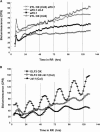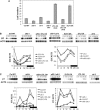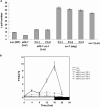Independent roles for EARLY FLOWERING 3 and ZEITLUPE in the control of circadian timing, hypocotyl length, and flowering time
- PMID: 16258016
- PMCID: PMC1283789
- DOI: 10.1104/pp.105.067173
Independent roles for EARLY FLOWERING 3 and ZEITLUPE in the control of circadian timing, hypocotyl length, and flowering time
Abstract
The circadian clock regulates many aspects of plant development, including hypocotyl elongation and photoperiodic induction of flowering. ZEITLUPE (ZTL) is a clock-related F-box protein, and altered ZTL expression causes fluence rate-dependent circadian period effects, and altered hypocotyl elongation and flowering time. EARLY FLOWERING 3 (ELF3) is a novel protein of unknown biochemical function. elf3 mutations cause light-dependent circadian dysfunction, elongated hypocotyls, and early flowering. Although both genes affect similar processes, their relationship is unclear. Here we show that the effects of ZTL and ELF3 on circadian clock function and early photomorphogenesis are additive. The long period of ztl mutations and ELF3 overexpressors are more severe than either alone. Dark-release experiments showing additivity in phase advances suggest that the arrthymicity caused by ZTL overexpression and that of the elf3-1 mutation arise through independent pathways. A similar additive effect on hypocotyl elongation in red and blue light is also observed. In contrast, ELF3 and ZTL overexpressors act similarly to control flowering time in long days through the CONSTANS/FLOWERING LOCUS T (CO/FT) pathway. ZTL overexpression does not delay flowering through changes in GIGANTEA or FLAVIN-BINDING, KELCH REPEAT, F-BOX levels, but through a ZTL-mediated reduction in CO expression. In contrast, ELF3 negatively regulates CO, FT, and GIGANTEA transcript levels, as the expression of all three genes is increased in elf3-1. The elf3-1 co-1 double mutant flowers much earlier in long days than co-1, although FT message levels remain very low. These results show that elf3-1 can derepress late flowering through a CO-independent mechanism. ELF3 may act at more than one juncture, possibly posttranscriptionally.
Figures







References
-
- Abe M, Kobayashi Y, Yamamoto S, Daimon Y, Yamaguchi A, Ikeda Y, Ichinoki H, Notaguchi M, Goto K, Araki T (2005) FD, a bZIP protein mediating signals from the floral pathway integrator FT at the shoot apex. Science 309: 1052–1056 - PubMed
-
- Alabadi D, Oyama T, Yanovsky MJ, Harmon FG, Mas P, Kay SA (2001) Reciprocal regulation between TOC1 and LHY/CCA1 within the Arabidopsis circadian clock. Science 293: 880–883 - PubMed
-
- Briggs WR, Christie JM (2002) Phototropins 1 and 2: versatile plant blue-light receptors. Trends Plant Sci 7: 204–210 - PubMed
-
- Chou ML, Yang CH (1999) Late-flowering genes interact with early-flowering genes to regulate flowering time in Arabidopsis thaliana. Plant Cell Physiol 40: 702–708 - PubMed
Publication types
MeSH terms
Substances
LinkOut - more resources
Full Text Sources
Molecular Biology Databases

